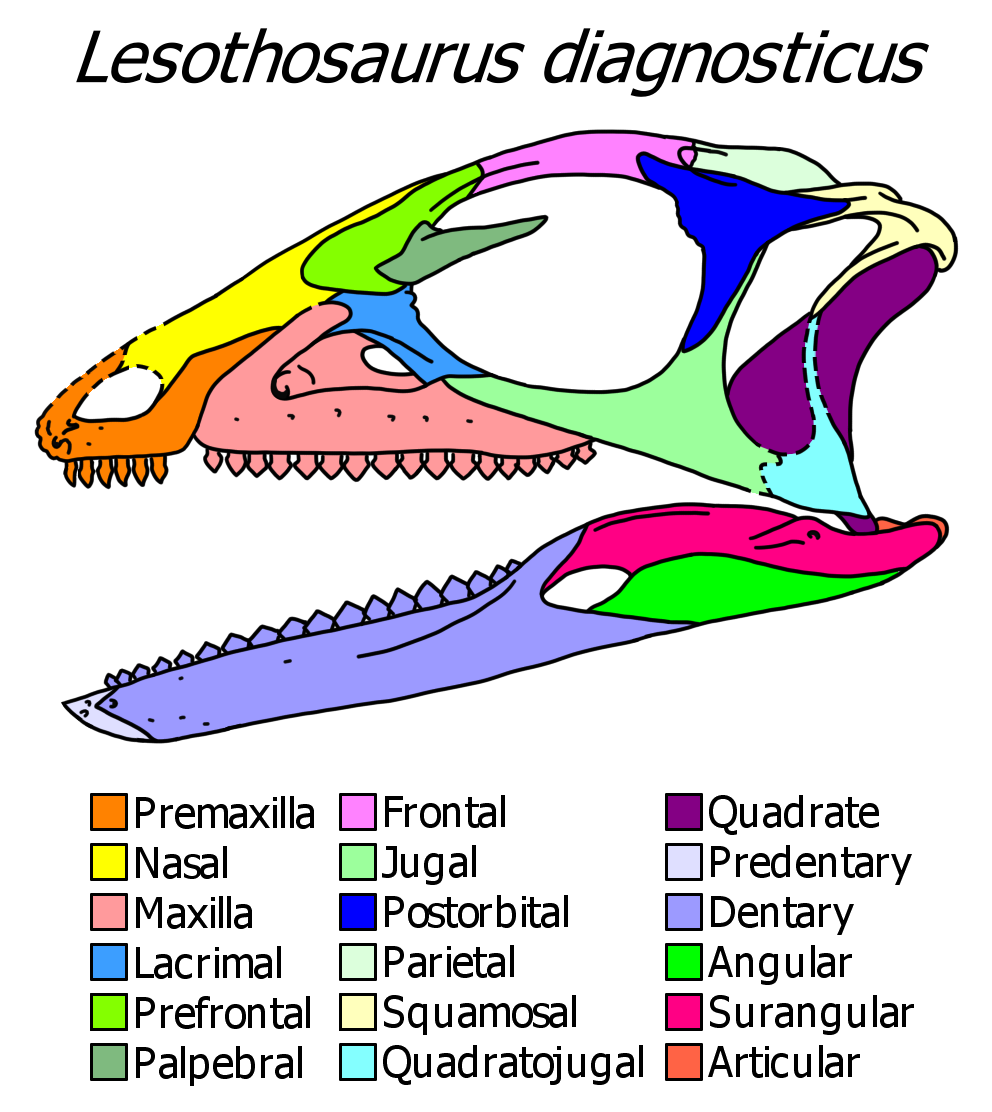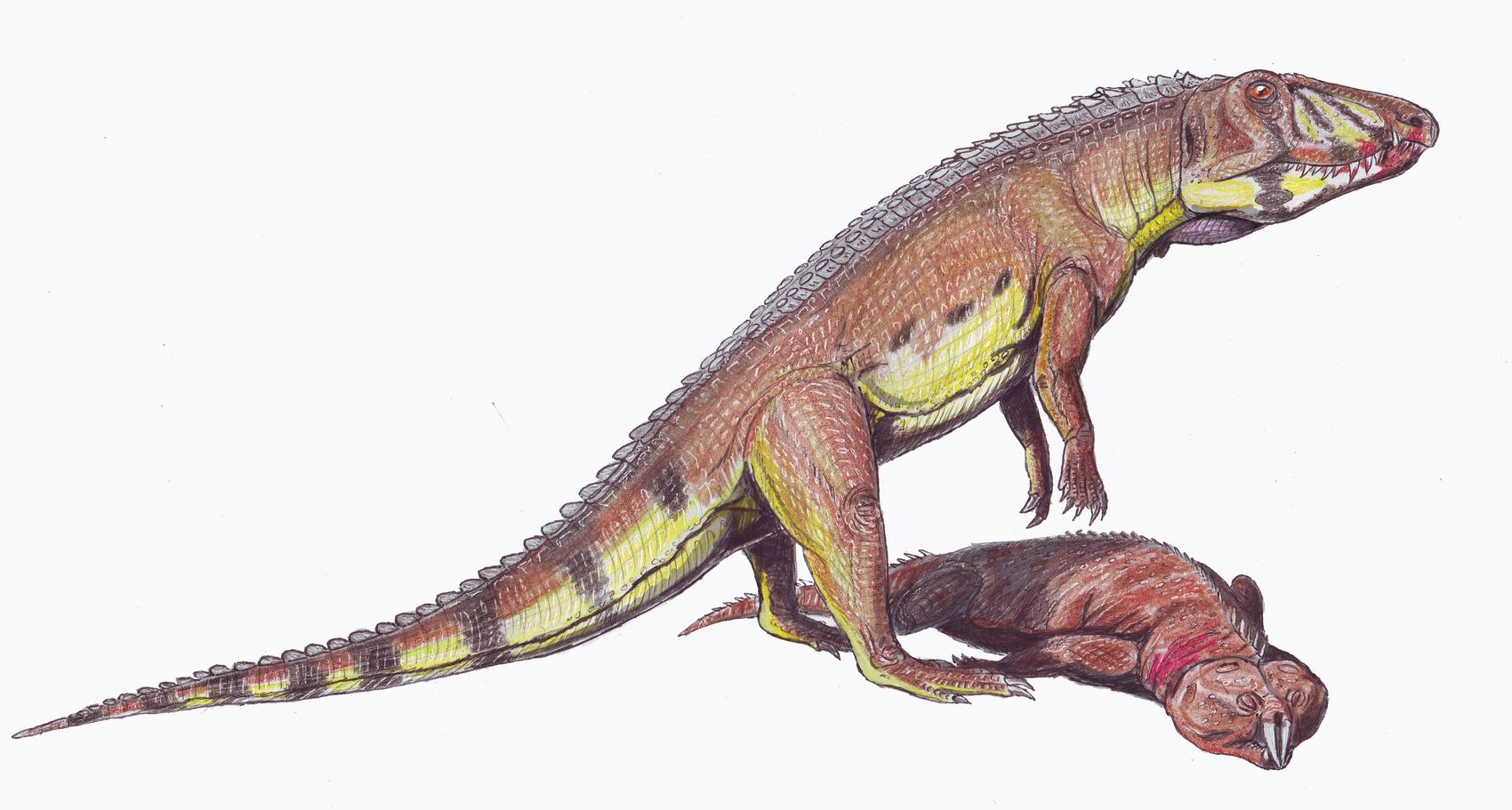|
Hyposphene
The hyposphene-hypantrum articulation is an accessory joint found in the vertebrae of several fossil reptiles of the group Archosauromorpha. It consists of a process on the backside of the vertebrae, the hyposphene, that fits in a depression in the front side of the next vertebrae, the hypantrum. Hyposphene-hypantrum articulations occur in the dorsal vertebrae and sometimes also in the posteriormost cervical and anteriormost caudal vertebrae. In most tetrapods including the human, the vertebrae are connected with each other only via the centrum and the zygapophysis joints. Additional joints like the hyposphene-hypantrum articulations, which add rigidity to the vertebral column, are found in several different reptile lineages; a known example are the zygosphene-zygantrum articulations found in snakes. Hyposphene-hypantrum articulations are found in several unrelated groups within the Archosauromorpha. They occur especially in large forms, for example in rauisuchids and in silesauri ... [...More Info...] [...Related Items...] OR: [Wikipedia] [Google] [Baidu] |
Dinosaur Anatomy
This glossary explains technical terms commonly employed in the description of dinosaur body fossils. Besides dinosaur-specific terms, it covers terms with wider usage, when these are of central importance in the study of dinosaurs or when their discussion in the context of dinosaurs is beneficial. The glossary does not cover ichnological and bone histological terms, nor does it cover measurements. A B C D E F G H I J L M N O P Q R S ... [...More Info...] [...Related Items...] OR: [Wikipedia] [Google] [Baidu] |
Titanosauria
Titanosaurs (or titanosaurians; members of the group Titanosauria) were a diverse group of Sauropoda, sauropod dinosaurs, including genera from all seven continents. The titanosaurs were the last surviving group of long-necked sauropods, with taxa still thriving at the time of the Cretaceous–Paleogene extinction event, extinction event at the end of the Cretaceous. This group includes some of the Largest land animal, largest land animals known to have ever existed, such as ''Patagotitan'', estimated at long with a mass of , and the comparably-sized ''Argentinosaurus'' and ''Puertasaurus'' from the Patagonia, same region. The group's name alludes to the mythological Titan (mythology), Titans of ancient Greek mythology, via the type genus (now considered a ''nomen dubium)'' ''Titanosaurus''. Together with the Brachiosauridae, brachiosaurids and relatives, titanosaurs make up the larger sauropod clade Titanosauriformes. Titanosaurs have long been a poorly-known group, and the rela ... [...More Info...] [...Related Items...] OR: [Wikipedia] [Google] [Baidu] |
Ornithischia
Ornithischia () is an extinct clade of mainly herbivorous dinosaurs characterized by a pelvic structure superficially similar to that of birds. The name ''Ornithischia'', or "bird-hipped", reflects this similarity and is derived from the Greek stem ' (), meaning "bird", and ' (), meaning "hip". However, as theropod dinosaurs, birds are only distantly related to this group. Ornithischians with well known anatomical adaptations include the ceratopsians or "horn-faced" dinosaurs (e.g. ''Triceratops''), the pachycephalosaurs or "thick-headed" dinosaurs, the armored dinosaurs ( Thyreophora) such as stegosaurs and ankylosaurs, and the ornithopods. There is strong evidence that certain groups of ornithischians lived in herds, often segregated by age group, with juveniles forming their own flocks separate from adults. Some were at least partially covered in filamentous (hair- or feather- like) pelts, and there is much debate over whether these filaments found in specimens of '' Ti ... [...More Info...] [...Related Items...] OR: [Wikipedia] [Google] [Baidu] |
Prezygapophysis
The articular process or zygapophysis ( + apophysis) of a vertebra is a projection of the vertebra that serves the purpose of fitting with an adjacent vertebra. The actual region of contact is called the ''articular facet''.Moore, Keith L. et al. (2010) ''Clinically Oriented Anatomy'', 6th Ed, p.442 fig. 4.2 Articular processes spring from the junctions of the pedicles and laminæ, and there are two right and left, and two superior and inferior. These stick out of an end of a vertebra to lock with a zygapophysis on the next vertebra, to make the backbone more stable. * The superior processes or prezygapophysis project upward from a lower vertebra, and their articular surfaces are directed more or less backward (oblique coronal plane). * The inferior processes or postzygapophysis project downward from a higher vertebra, and their articular surfaces are directed more or less forward and outward. The articular surfaces are coated with hyaline cartilage. In the cervical vertebr ... [...More Info...] [...Related Items...] OR: [Wikipedia] [Google] [Baidu] |
Rebbachisauridae
Rebbachisauridae is a family of sauropod dinosaurs known from fragmentary fossil remains from the Cretaceous of South America, Africa, North America, Europe and possibly Central Asia. Taxonomy In 1990 sauropod specialist Jack McIntosh included the first known rebbachisaurid genus, the giant North African sauropod '' Rebbachisaurus'', in the family Diplodocidae, subfamily Dicraeosaurinae, on the basis of skeletal details. With the discovery in subsequent years of a number of additional genera, it was realised that ''Rebbachisaurus'' and its relatives constituted a distinct group of dinosaurs. In 1997 the Argentine paleontologist José Bonaparte described the family Rebbachisauridae, and in 2011 Whitlock defined two new subfamilies within the group: Nigersaurinae and Limaysaurinae. Khebbashia is a clade within Rebbachisauridae. P. D. Mannion, P. Upchurch, D. Schwarz and O. Wings. (2019). Taxonomic affinities of the putative titanosaurs from the Late Jurassic Tendaguru Formatio ... [...More Info...] [...Related Items...] OR: [Wikipedia] [Google] [Baidu] |
Prosauropod
Sauropodomorpha ( ; from Greek, meaning "lizard-footed forms") is an extinct clade of long-necked, herbivorous, saurischian dinosaurs that includes the Sauropoda, sauropods and their ancestral relatives. Sauropods generally grew to very large sizes, had long necks and tails, were quadrupedal, and became the largest animals to ever walk the Earth. The primitive sauropodomorphs which preceded the sauropods, and are informally called prosauropods, were smaller and were often able to walk on two legs. The sauropodomorphs were the dominant terrestrial herbivores throughout much of the Mesozoic Era, from their origins in the Late Triassic (approximately 230 Myr, Ma) until their decline and extinction at the end of the Cretaceous. History of study Early study Gigantic bones of sauropods have been known for thousands of years and become part of legends and cultures but the beginning of their scientific study was in the 1830s. Most of the early taxonomy was based on incomplete and disarti ... [...More Info...] [...Related Items...] OR: [Wikipedia] [Google] [Baidu] |
Sauropodomorpha
Sauropodomorpha ( ; from Greek, meaning "lizard-footed forms") is an extinct clade of long-necked, herbivorous, saurischian dinosaurs that includes the sauropods and their ancestral relatives. Sauropods generally grew to very large sizes, had long necks and tails, were quadrupedal, and became the largest animals to ever walk the Earth. The primitive sauropodomorphs which preceded the sauropods, and are informally called prosauropods, were smaller and were often able to walk on two legs. The sauropodomorphs were the dominant terrestrial herbivores throughout much of the Mesozoic Era, from their origins in the Late Triassic (approximately 230 Ma) until their decline and extinction at the end of the Cretaceous. History of study Early study Gigantic bones of sauropods have been known for thousands of years and become part of legends and cultures but the beginning of their scientific study was in the 1830s. Most of the early taxonomy was based on incomplete and disarticulated mater ... [...More Info...] [...Related Items...] OR: [Wikipedia] [Google] [Baidu] |
Rahonavis
''Rahonavis'' is a genus of bird-like theropod from the Late Cretaceous (Maastrichtian, from about 72.1 to 66 mya) of what is now northwestern Madagascar. It is known from a partial skeleton ( UA 8656) found by Catherine Forster and colleagues in Maevarano Formation rocks at a quarry near Berivotra, Mahajanga Province.Tudge, Colin (2009) ''The Bird:A Natural History of Who Birds Are, Where They Came From, and How They Live'/ref> ''Rahonavis'' was a small predator, at about long and 0.45-2.27 kg (1-5 lbs),Holtz, Thomas R. Jr. (2008) ''Dinosaurs: The Most Complete, Up-to-Date Encyclopedia for Dinosaur Lovers of All Ages'Supplementary Information/ref> with the typical Dromaeosauridae, dromaesaurid-like raised sickle claw on the second toe. It was originally the first African coelurosaur until the discovery of ''Nqwebasaurus'' in 2000. The name ''Rahonavis'' means, approximately, "cloud menace bird", from Malagasy ' (RA-hoo-na, "cloud" or "menace") + Latin ' "bird". The specifi ... [...More Info...] [...Related Items...] OR: [Wikipedia] [Google] [Baidu] |
Dromaeosauridae
Dromaeosauridae () is a family of feathered coelurosaurian theropod dinosaurs. They were generally small to medium-sized feathered carnivores that flourished in the Cretaceous Period. The name Dromaeosauridae means 'running lizards', from Greek ('), meaning 'running at full speed', 'swift', and ('), meaning 'lizard'. In informal usage, they are often called raptors (after '' Velociraptor''), a term popularized by the film ''Jurassic Park''; several genera include the term "raptor" directly in their name, and popular culture has come to emphasize their bird-like appearance and speculated bird-like behavior. Dromaeosaurid fossils have been found across the globe in North America, Europe, Africa, Asia and South America, with some fossils giving credence to the possibility that they inhabited Australia as well. The earliest body fossils are known from the Early Cretaceous (145–140 million years ago), and they survived until the end of the Cretaceous (Maastrichtian stage, 66 ... [...More Info...] [...Related Items...] OR: [Wikipedia] [Google] [Baidu] |
Synapomorphy
In phylogenetics, an apomorphy (or derived trait) is a novel Phenotypic trait, character or character state that has evolution, evolved from its ancestral form (or Plesiomorphy and symplesiomorphy, plesiomorphy). A synapomorphy is an apomorphy shared by two or more taxon, taxa and is therefore Hypothesis#Scientific hypothesis, hypothesized to have evolved in their most recent common ancestor. ) In cladistics, synapomorphy implies Homology (biology), homology. Examples of apomorphy are the presence of Terrestrial locomotion#Posture, erect gait, fur, Evolution of mammalian auditory ossicles, the evolution of three middle ear bones, and mammary glands in mammals but not in other vertebrate animals such as amphibians or reptiles, which have retained their ancestral traits of a Terrestrial locomotion#Posture, sprawling gait and lack of fur. Thus, these derived traits are also synapomorphies of mammals in general as they are not shared by other vertebrate animals. Etymology The word ... [...More Info...] [...Related Items...] OR: [Wikipedia] [Google] [Baidu] |
Archosauromorpha
Archosauromorpha ( Greek for "ruling lizard forms") is a clade of diapsid reptiles containing all reptiles more closely related to archosaurs (such as crocodilians and dinosaurs, including birds) than to lepidosaurs (such as tuataras, lizards, and snakes). Archosauromorphs first appeared during the late Middle Permian or Late Permian, though they became much more common and diverse during the Triassic period. Although Archosauromorpha was first named in 1946, its membership did not become well-established until the 1980s. Currently Archosauromorpha encompasses four main groups of reptiles: the stocky, herbivorous allokotosaurs and rhynchosaurs, the hugely diverse Archosauriformes, and a polyphyletic grouping of various long-necked reptiles including '' Protorosaurus'', tanystropheids, and '' Prolacerta''. Other groups including pantestudines (turtles and their extinct relatives) and the semiaquatic choristoderes have also been placed in Archosauromorpha by some authors ... [...More Info...] [...Related Items...] OR: [Wikipedia] [Google] [Baidu] |






